I don't know how to draw. At all. Not a bit.
Once, when I was in the first grade, the teacher gave me a task: to draw a frog. For me, this task was from the category of "impossible". But, being a diligent student, I spent the whole evening diligently displaying bulging eyes and green paws. If you only knew how bitterly I cried when the next day I received a "swan" for my frog.
I liked the book "Visual Thinking" right away, because literally on the first pages it says: "... the success of solving problems with the help of visual images does not depend on artistic talent ...".
It doesn't matter if you can draw. Visual thinking is not a gift, it is an ability. And Dan Roem can teach anyone to look, see, imagine and show.
Dan Roem is a world–renowned expert in the field of visual thinking. Dan has two academic degrees (in fine arts and biology), and he runs a large consulting company that helps businessmen solve their most difficult problems with the help of drawings. His clients include Microsoft, eBay, Google, Wal–Mart, Boeing, Intel, IBM.
In addition, Dan is the author of several books that have become bestsellers in Russia and many other countries. The first of them is "Blah, blah, blah. What to do when words don't work", the second is "Visual thinking".
Visual thinking means taking advantage of a person's natural ability to see – not only through the eyes, but also mentally, allowing them to discover ideas that would otherwise go unnoticed; to develop them quickly and intuitively, and then convey them to other people in such a way that others quickly understand and accept them – that is, to popularize.
(c) dan Roem. "Visual thinking"
It turns out that any – absolutely any – problem can be drawn. And having drawn, decide. To do this, nature has rewarded us with universal basic visualization tools – eyes, hands and imagination. To use them successfully, you need to ask questions: "who/ what?", "how much?", "where?", "when?", "how?" and "why/why?", as well as SQVID questions. As a result, you will learn how to collect and filter information (look); select and group it (see); find what is not there (imagine); and explain (show to others).
So, my problem is to tell you (smart and inquisitive readers) about the book by Dan Roem (the genius of visualization).
The frog, by comparison, is just resting. But I'll try anyway.
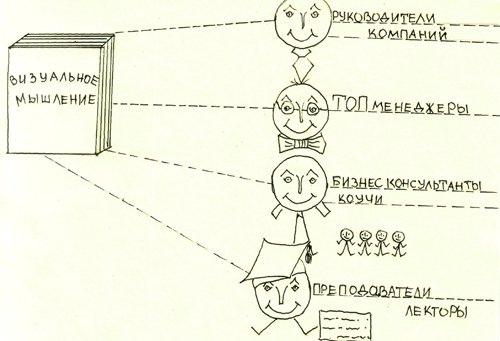
The book will be useful for those who generate ideas and face the need to convey them to others (subordinates, colleagues, clients). That is, the heads of medium and large companies and senior managers.
Words are sometimes not enough. A computer presentation illustrates the problem, but does not solve it. Many managers and leading managers often remain unheard, and therefore misunderstood.
Drawing is another matter. It is based on serious analytical work aimed at seeing what (allegedly) does not exist. Thanks to visualization, words are transformed not into a way of conveying information, but into a means. An idea drawn on paper instantly "comes to life" in a person's mind, you just need to verbally clarify the details.
That is why, in my opinion, Dan Roem's book will also be useful for business consultants, university teachers and people in general who often speak to the public.
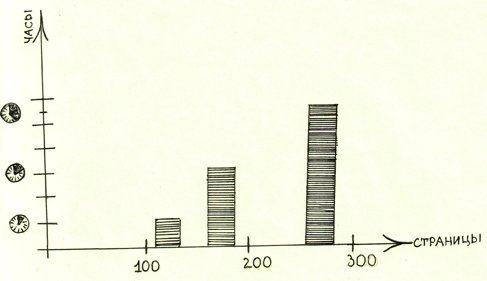
Usually on the flyleaf of books from "MYTH" the approximate time of their reading is indicated. In this case, there is no such information. At first it seemed strange to me, but then I realized why.
It is impossible to predict how long it will take you to read this book. Maybe an hour, maybe two, maybe a week.
Why? After all, there is not much text in it, and the syllable of the presentation resembles a textbook for elementary grades (simple words, short phrases). 60% of the volume of the book is pictures.
This is where the "trap" lies. The first, let's say, purely "theoretical" part of the book, where the basic principles of visual thinking are revealed, I read literally in an hour.
But familiarization with only two (!) chapters (6th and 7th) took me as much as 3 hours! I spent a long time "hanging" over the pictures, analyzing, trying to come up with my own examples, studying visualization tools, etc.
It took me another hour and a half to get acquainted with a specific example of the use of visual thinking, as well as to come up with my own.
Total – 5.5 hours. Who is bigger?
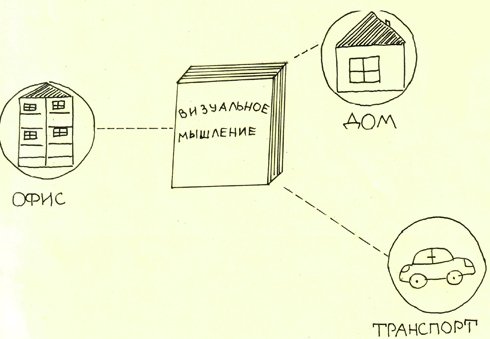
The book has a soft cover and a somewhat unusual shape. In appearance, it resembles a photo album.
The width of the printed edition is 21 cm, in the spread – 42. As you understand, it is not very convenient to hold such a book in your hands or on your lap. Therefore, you should not read it in a car, plane or other transport.
To do this, you need a good table (not a small one in a cafe). It is best to learn the basics of visual thinking at a desk at work (provided that you will not be distracted) or at home.
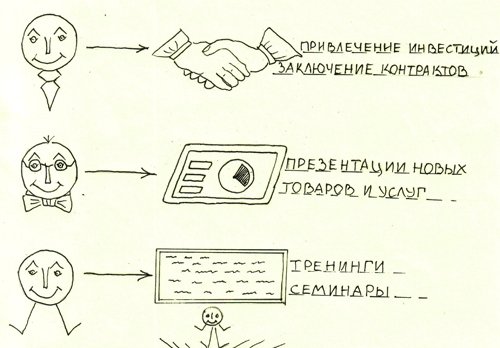
Visual thinking skills will be useful at all times. Ideally, you should master them so much that at any moment (in a cafe for a business lunch or during a brainstorming session) you can take a pen and draw a problem and its solution.
In fact, the heads of firms, in my opinion, should read this book if they soon have important business negotiations (for example, with potential investors). Managers – before presentations of new products or services. And business consultants should keep this book at hand at all times.

I always read paper books with a pencil in my hands. To make notes, highlight important things, write out new words.
Reading "Visual Thinking", I also had to arm myself with a notebook. All the time I want to draw, build graphs and diagrams. And it doesn't matter if you are a "black", "yellow" or "red" pen – you can't do without paper. It is a pity that there are no blank sheets in the book itself for the "pen test".
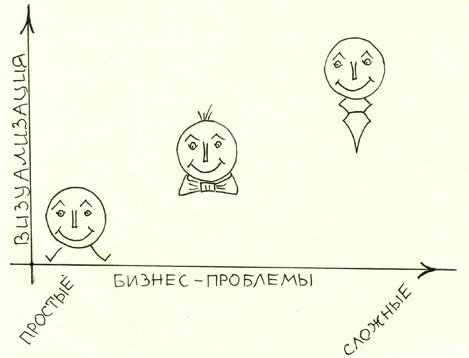
Graphic images are a powerful tool for solving business problems of varying complexity. The most difficult of them are faced, as a rule, by company executives, so for them Dan Roem's book "Visual Thinking" is one of the ways to make their business more successful.
Managers of various levels often have to convince clients and colleagues of the correctness of their undertakings – the task is also not easy. You can solve it by drawing what you see with your inner vision.
But even if you are far from the business environment and your problem today is to draw a frog, visual thinking - the ability to look, see, imagine and show – will help you.
"Visual thinking. How to "sell" your ideas using visual images", Dan Roem
Buy on litres.ru Buy on amazon
Instagram Facebook and social networks owned by Meta Platforms Inc. are prohibited from operating in the territory of the Russian Federation.*